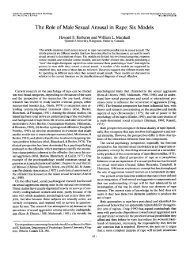Regulation of the dopamine transporter - Addiction Research ...
Regulation of the dopamine transporter - Addiction Research ...
Regulation of the dopamine transporter - Addiction Research ...
You also want an ePaper? Increase the reach of your titles
YUMPU automatically turns print PDFs into web optimized ePapers that Google loves.
Schmitt & Reith DAT <strong>Regulation</strong><br />
DAT regulation have yet to be elucidated, we<br />
will attempt to highlight instances where DATaffecting<br />
drugs may directly influence intracellular<br />
signaling cascades (which can, in turn, affect<br />
DAT regulation). We will also briefly discuss <strong>the</strong> involvement<br />
<strong>of</strong> presynaptic GPCRs and <strong>transporter</strong>associated<br />
scaffolding proteins in DAT regulation.<br />
Finally, <strong>the</strong> possible implications <strong>of</strong> <strong>transporter</strong><br />
protein regulation to <strong>the</strong> putative toxicity <strong>of</strong> several<br />
substituted amphetamine derivatives will be<br />
discussed.<br />
Direct regulation <strong>of</strong> <strong>transporter</strong> function by<br />
DAT ligands<br />
Effects <strong>of</strong> <strong>transporter</strong> substrates<br />
Substrates that are actively translocated by <strong>the</strong><br />
DAT (o<strong>the</strong>r than <strong>dopamine</strong> itself) include endogenous<br />
trace amines, such as tyramine and �phenethylamine,<br />
<strong>the</strong> neurotoxic mitochondrial poison<br />
1-methyl-4-phenylpyridinium (MPP + ), and<br />
<strong>the</strong> amphetamines, such as <strong>the</strong> clinically used<br />
stimulant d-amphetamine and its more potent<br />
congener d-methamphetamine, a highly-abused<br />
addictive drug. 20 Extracellular substrates can produce<br />
ei<strong>the</strong>r transient upregulation or significant<br />
downregulation <strong>of</strong> DAT activity, depending on <strong>the</strong><br />
duration <strong>of</strong> substrate exposure. Evidence that substrates<br />
for <strong>the</strong> DAT can induce rapid alterations<br />
in <strong>transporter</strong> activity was first obtained in striatal<br />
synaptosomes prepared from rats 1 h after treatment<br />
with high-dose d-methamphetamine (15 mg/kg <strong>of</strong><br />
body weight). At this dose, acute methamphetamine<br />
administration resulted in a 65% decrease in synaptosomal<br />
[ 3H]<strong>dopamine</strong> uptake compared with<br />
vehicle. 21 Fur<strong>the</strong>r analysis showed that this<br />
downregulation is transient—it was observed in<br />
synaptosomes prepared 1 h after, but not 24 h after,<br />
methamphetamine treatment—and is due to<br />
a treatment-associated drop in transport velocity<br />
(V max), not an alteration in <strong>the</strong> <strong>transporter</strong>’s affinity<br />
(Km) for <strong>dopamine</strong> and is not associated with<br />
changes in overall DAT protein concentration. 22<br />
These data are consistent with <strong>the</strong> hypo<strong>the</strong>sis<br />
that methamphetamine rapidly and transiently diminishes<br />
<strong>the</strong> activity <strong>of</strong> <strong>the</strong> DAT at <strong>the</strong> cell surface;<br />
however, <strong>the</strong>y do not distinguish between a<br />
trafficking-dependent mechanism (internalization<br />
<strong>of</strong> plasmalemmal <strong>transporter</strong>s) and a posttranslational<br />
regulatory effect at <strong>the</strong> individual <strong>transporter</strong><br />
level. Support for a trafficking-dependent mechanism<br />
has come from fur<strong>the</strong>r research employing<br />
fluorescent microscopy to visualize tagged human<br />
DAT (hDAT) fusion proteins expressed in cultured<br />
cells. For example, Saunders et al. demonstrated that<br />
exposing HEK293 cells transfected with fluorescenttagged<br />
hDAT to d-amphetamine triggers migration<br />
<strong>of</strong> <strong>the</strong> fluorescent DAT from <strong>the</strong> cell surface<br />
to <strong>the</strong> intracellular compartment, with visible DAT<br />
accumulation in punctate intracellular vesicles. 23<br />
In line with <strong>the</strong> previous findings for methamphetamine,<br />
preincubation <strong>of</strong> <strong>the</strong> HEK-hDAT cells<br />
with amphetamine for 1 h significantly reduced<br />
cellular [ 3 H]<strong>dopamine</strong> uptake, affecting <strong>the</strong> V max<br />
transport parameter but not <strong>the</strong> Km for <strong>dopamine</strong>.<br />
Amphetamine-induced <strong>transporter</strong> internalization<br />
was apparent after as little as 20 min (maximal at 1-h<br />
exposure time) and was found to be dependent on<br />
internalization <strong>of</strong> <strong>the</strong> DAT by clathrin-coated vesicles,<br />
as coexpression <strong>of</strong> a dominant-negative form<br />
<strong>of</strong> dynamin I—a GTPase responsible for cleaving<br />
nascent clathrin-coated vesicles budding from <strong>the</strong><br />
plasma membrane—in <strong>the</strong> HEK-hDAT cells prevented<br />
<strong>the</strong> internalizing effect <strong>of</strong> amphetamine. 23<br />
The authors also noted that <strong>dopamine</strong> itself causes<br />
a similar redistribution <strong>of</strong> plasmalemmal DAT to<br />
intracellular vesicles (albeit at a higher dosage than<br />
amphetamine), implying that regulation <strong>of</strong> surface<br />
DAT expression is a general effect <strong>of</strong> substratelike<br />
compounds. Extending this qualitative observation,<br />
Chi and Reith found that pretreatment with<br />
<strong>dopamine</strong> for 1 h decreases surface DAT expression<br />
by approximately 30% in both HEK-hDAT cells<br />
and rat striatal synaptosomes, an effect that cleavable<br />
biotinylation assays suggest is due to enhanced<br />
endocytosis <strong>of</strong> <strong>the</strong> <strong>transporter</strong> protein. 24 Fur<strong>the</strong>r<br />
corroboration <strong>of</strong> increased internalization and sequestration<br />
<strong>of</strong> surface-localized <strong>transporter</strong>s in response<br />
to substrates is provided by <strong>the</strong> fluorescent<br />
microscopy studies <strong>of</strong> Sorkina et al., who visualized<br />
amphetamine-mediated DAT endocytosis in<br />
living cells and later demonstrated that internalized<br />
DATs colocalize with well-characterized markers <strong>of</strong><br />
early and recycling endosomes, such as Rab5 and<br />
EEA1. 25,26<br />
In what quaternary form is DAT internalized by<br />
<strong>the</strong> action <strong>of</strong> amphetamine? Is <strong>the</strong>re a relationship<br />
between <strong>the</strong> oligomerization <strong>of</strong> DAT and its internalization?<br />
We found that in hDAT-expressing HEK-<br />
293 cells, d-amphetamine shifted <strong>the</strong> distribution <strong>of</strong><br />
Ann. N.Y. Acad. Sci. 1187 (2010) 316–340 c○ 2010 New York Academy <strong>of</strong> Sciences. 319










